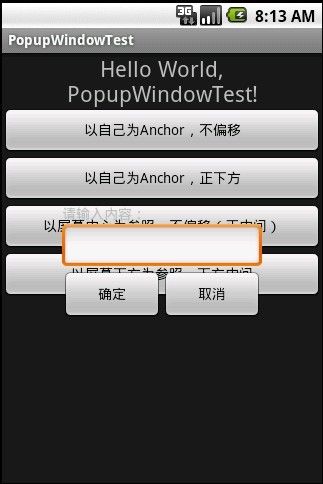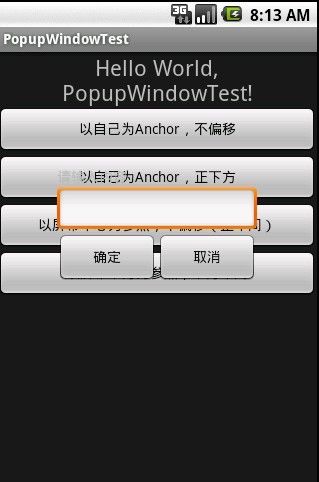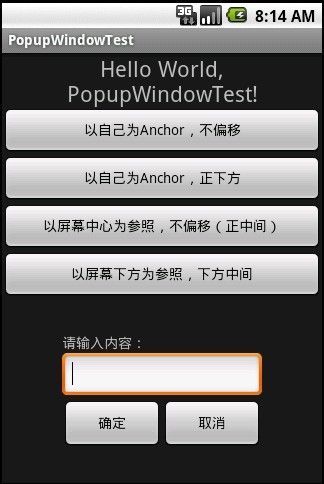Android之PopupWindow弹出对话框
转载自:http://blog.csdn.net/kkfdsa132/article/details/6376518#
Android的对话框常用的有两种:PopupWindow和AlertDialog。PopupWindow顾名思义为弹出菜单,不同于AlertDialog对话框,PopupWindow弹出的位置可以很多变化,按照有无偏移分,可以分为无偏移和偏移两种;按照参照类型不同又可以分为两种:相对某个控件(Anchor锚)的位置和父容器内部的相对位置。具体如下:
| 函数 | 简介 |
| showAsDropDown(View anchor) | 相对某个控件的位置(正左下方),无偏移 |
| showAsDropDown(View anchor, int xoff, int yoff) | 相对某个控件的位置,有偏移 |
| showAtLocation(View parent, int gravity, int x, int y) | 父容器容器相对位置,例如正中央Gravity.CENTER,下方Gravity.BOTTOM等 |
下面是运行程序截图:
程序代码:
布局:main.xml
<?xml version="1.0" encoding="utf-8"?>
<LinearLayout xmlns:android="http://schemas.android.com/apk/res/android"
android:id="@+id/layout"
android:orientation="vertical"
android:layout_width="fill_parent"
android:layout_height="fill_parent"
>
<TextView
android:id="@+id/tv_showText"
android:layout_width="fill_parent"
android:layout_height="wrap_content"
android:gravity="center"
android:text="@string/hello"
android:textSize="22px"
/>
<Button
android:id="@+id/bt_PopupWindow1"
android:text="以自己为Anchor,不偏移"
android:layout_width="fill_parent"
android:layout_height="wrap_content"
/>
<Button
android:id="@+id/bt_PopupWindow2"
android:text="以自己为Anchor,正下方"
android:layout_width="fill_parent"
android:layout_height="wrap_content"
/>
<Button
android:id="@+id/bt_PopupWindow3"
android:text="以屏幕中心为参照,不偏移(正中间)"
android:layout_width="fill_parent"
android:layout_height="wrap_content"
/>
<Button
android:id="@+id/bt_PopupWindow4"
android:text="以屏幕下方为参照,下方中间"
android:layout_width="fill_parent"
android:layout_height="wrap_content"
/>
</LinearLayout>
自定义对话框dialog.xml
<?xml version="1.0" encoding="utf-8"?>
<LinearLayout xmlns:android="http://schemas.android.com/apk/res/android"
android:orientation="vertical"
android:layout_width="fill_parent"
android:layout_height="fill_parent"
>
<TextView
android:id="@+id/tv_tip"
android:layout_width="fill_parent"
android:layout_height="wrap_content"
android:text="请输入内容:"
/>
<EditText
android:id="@+id/et_text"
android:layout_width="fill_parent"
android:layout_height="wrap_content"
></EditText>
<LinearLayout
android:gravity="center_horizontal"
android:layout_width="fill_parent"
android:layout_height="fill_parent"
>
<Button
android:id="@+id/bt_ok"
android:text="确定"
android:layout_width="100px"
android:layout_height="50px"
/>
<Button
android:id="@+id/bt_cancle"
android:text="取消"
android:layout_width="100px"
android:layout_height="50px"
/>
</LinearLayout>
</LinearLayout>
代码:
package com.myandroid.test;
import android.app.Activity;
import android.content.Context;
import android.content.SharedPreferences.Editor;
import android.os.Bundle;
import android.util.Log;
import android.view.Gravity;
import android.view.LayoutInflater;
import android.view.View;
import android.view.View.OnClickListener;
import android.view.ViewGroup.LayoutParams;
import android.widget.Button;
import android.widget.EditText;
import android.widget.Gallery;
import android.widget.PopupWindow;
import android.widget.TextView;
public class PopupWindowTest extends Activity {//PopupWindow属于不阻塞的对话框,AlertDialog则是阻塞的。
private Button bt_popupWindow1;
private Button bt_popupWindow2;
private Button bt_popupWindow3;
private Button bt_popupWindow4;
private TextView tv_showText;
private PopupWindow popupWindow;
private int screenWidth;
private int screenHeight;
private int dialgoWidth;
private int dialgoheight;
/** Called when the activity is first created. */
@Override
public void onCreate(Bundle savedInstanceState) {
super.onCreate(savedInstanceState);
setContentView(R.layout.main);
initView();
}
/**
* 初始化控件和响应事件
*/
private void initView() {
bt_popupWindow1 = (Button)findViewById(R.id.bt_PopupWindow1);
bt_popupWindow2 = (Button)findViewById(R.id.bt_PopupWindow2);
bt_popupWindow3 = (Button)findViewById(R.id.bt_PopupWindow3);
bt_popupWindow4 = (Button)findViewById(R.id.bt_PopupWindow4);
tv_showText = (TextView)findViewById(R.id.tv_showText);
bt_popupWindow1.setOnClickListener(new ClickEvent());
bt_popupWindow2.setOnClickListener(new ClickEvent());
bt_popupWindow3.setOnClickListener(new ClickEvent());
bt_popupWindow4.setOnClickListener(new ClickEvent());
}
/**
* 按钮点击事件处理
* @author Kobi
*
*/
private class ClickEvent implements OnClickListener {
@Override
public void onClick(View v) {
// TODO Auto-generated method stub
switch(v.getId()) {
case R.id.bt_PopupWindow1: //以自己为Anchor,不偏移
getPopupWindow();
popupWindow.showAsDropDown(v);
break;
case R.id.bt_PopupWindow2: //以自己为Anchor,偏移(screenWidth-dialgoWidth)/2, 0)--按钮正下方
getPopupWindow();
popupWindow.showAsDropDown(v, (screenWidth-dialgoWidth)/2, 0);
break;
case R.id.bt_PopupWindow3: //以屏幕中心为参照,不偏移
getPopupWindow();
popupWindow.showAtLocation(findViewById(R.id.layout), Gravity.CENTER, 0, 0);
break;
case R.id.bt_PopupWindow4: //以屏幕左下角为参照,偏移(screenWidth-dialgoWidth)/2, 0) --屏幕下方中央
getPopupWindow();
popupWindow.showAtLocation(findViewById(R.id.layout),
Gravity.BOTTOM, 0, 0);
break;
default:
break;
}
}
}
/**
* 创建PopupWindow
*/
protected void initPopuptWindow() {
// TODO Auto-generated method stub
View popupWindow_view = getLayoutInflater().inflate( //获取自定义布局文件dialog.xml的视图
R.layout.dialog, null,false);
popupWindow = new PopupWindow(popupWindow_view, 200, 150, true);//创建PopupWindow实例
Button bt_ok = (Button)popupWindow_view.findViewById(R.id.bt_ok); //dialog.xml视图里面的控件
Button bt_cancle = (Button)popupWindow_view.findViewById(R.id.bt_cancle);
final EditText et_text = (EditText)popupWindow_view.findViewById(R.id.et_text);
bt_ok.setOnClickListener(new OnClickListener() {
@Override
public void onClick(View v) {
// TODO Auto-generated method stub
tv_showText.setText(et_text.getText()); //在标签里显示内容
popupWindow.dismiss(); //对话框消失
}
});
bt_cancle.setOnClickListener(new OnClickListener() {
@Override
public void onClick(View v) {
// TODO Auto-generated method stub
popupWindow.dismiss();
}
});
//获取屏幕和对话框各自高宽
screenWidth = PopupWindowTest.this.getWindowManager().getDefaultDisplay().getWidth();
screenHeight = PopupWindowTest.this.getWindowManager().getDefaultDisplay().getHeight();
dialgoWidth = popupWindow.getWidth();
dialgoheight = popupWindow.getHeight();
}
/*
* 获取PopupWindow实例
*/
private void getPopupWindow() {
if(null != popupWindow) {
popupWindow.dismiss();
return;
}else {
initPopuptWindow();
}
}
@Override
protected void onPause() {
// TODO Auto-generated method stub
super.onPause();
Log.e("ActivityState", "onPause");
}
@Override
protected void onResume() {
// TODO Auto-generated method stub
super.onResume();
Log.e("ActivityState", "onResume");
}
}



